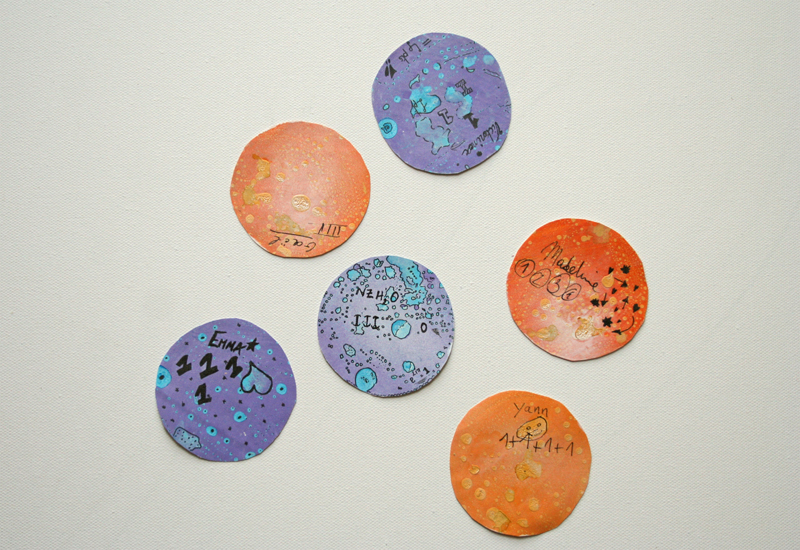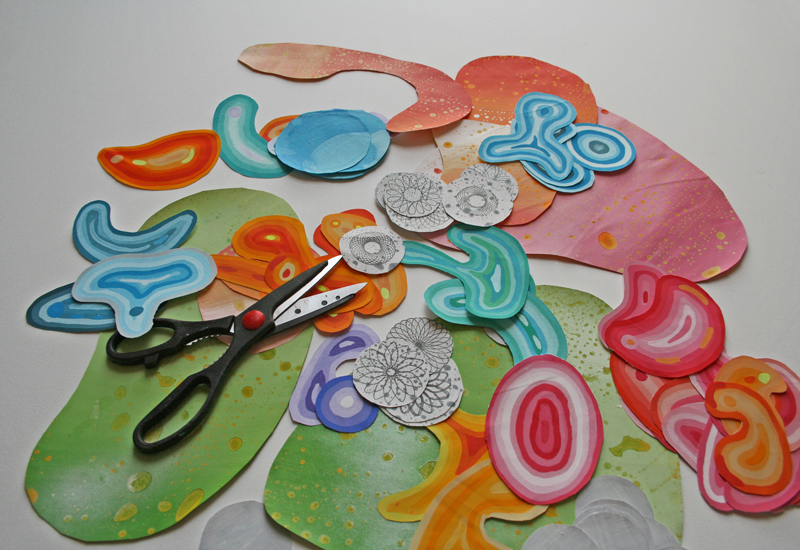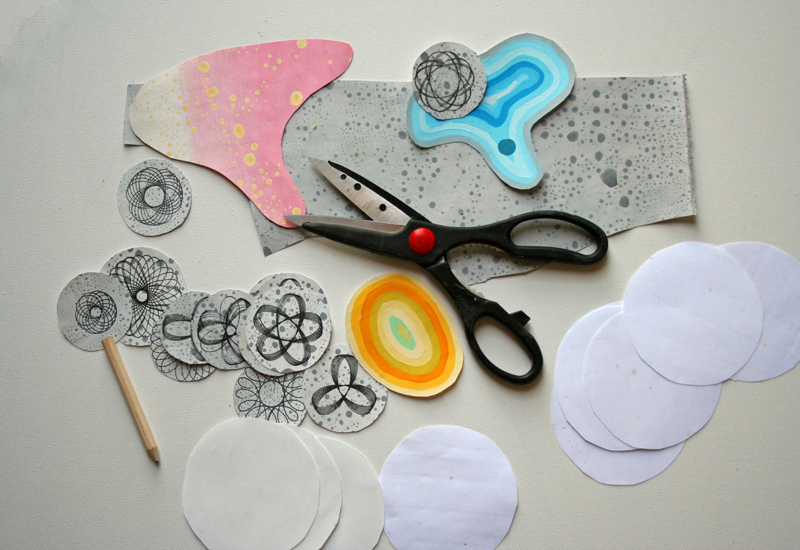The line of the day
Work : The line of the day
Board game based on the concept of storytelling. A narration intended for the general public, aiming to influence people’s minds and lead them to certain behaviours. Pictorial elements which resuted in textual, pictorial, photograpic, audio as well as video works.
This game, with rules similar to those of Pictionary was played by about ten groups of 6 to 12 players.
Location : Various places, France 2011.
Reference text :
Montpellier, June 11, 2011,
I had this idea in an airport, that of Cairo. Through the boarding gate next to mine, groups of pilgrims bound for Mecca rushed in, dressed in irham. Despite several months spent immersed in Muslim culture, I was not yet, far from it, familiar with all its uses. To tell the truth, in the aisles of the terminal, I had taken the first three believers I had encountered in this very simple device – two pieces of seamless white fabric wrapped around their naked bodies, one at the top, one at the bottom – for customers of an improbable sauna located in shopping malls. I imagined them waiting for their skin to dry while walking around, a little hesitant, wearing terry towels that were too small. I would like to point out that after two years of tribulations around the world, this eventuality would not have shocked me any more than travelers without shoes having the dead skin on their feet nibbled by fish in an aquarium lit with fluorescent lights. No more than those Korean adventurer apprentices asleep on huge purring massage seats or the Thai workers having their hair cut by the dozen in a train station where the few rows of plastic seats served as a hairdressing salon shocked me.
This spiritual relationship with the fabric reminded me, in Jerusalem, of those Orthodox Jews of whom I always saw a few worn threads protruding from their invariably black clothes – the tsitsits which fringe the four corners of the Tallit and evoke the sacred commandments of the Torah – subtle strings which intrigued me a lot at first. In the same vein, I was also thinking of the non-woven fabric of the tunic with which certain passages in the Bible dress Jesus. Recently, I read that, for the time, they evoked an external sign of nobility and not, as some exegetes have written, of poverty.
In a more profane way, I also remembered my hours spent, in the fragrant darkness of the souqs of Damascus and Aleppo (battered cities) looking, like a good “tourist”, for the carpet that I already imagined proudly rolling out on my living room floor. Getting lost in the alleys and backyards, I ended up coming across lovers of weaving, restorers of century-old pieces. I found myself face to face with craftsmen possessing know-how whose origins were intertwined with that of humanity. With eyes half-closed and skin as worn as the works whose life they prolonged, these living parchments told me their story, a story of naked men, of nomads, a story that went back to the childhood of the world. A story whose solid thread, made of eternal beginnings, passed in the back and forth of a needle…
When I finally chose my rug. The person who sold it to me “read” it to me. To do so, he began by telling me about his childhood, that of a fourteen-year-old boy sent alone to Afghanistan to meet a master. This one was an old man no longer profitable enough to work for anything other than young souls. Like Al-Farabi, day after day, at dawn in the mountains, he repeated to his little student who was struggling to emerge from the warm sleep of winter: “When you sleep, you steal your life.” So my seller had learned the language of carpets, that of the foothills of the Hindu Kush, that used, long before him, by the shepherds of Mesopotamia. It was on the part of the old spiritual father that his disciple, fifty years later, insisted on proving to me that the weaving was confused with the text, this fabric of words that our thoughts weave, these shared words which are themselves tight bonds between men.
So, I wanted to look into all these stories. I wanted to know more about those of the great monotheistic religions, about those, too, that we talk about in the bistro, in the schoolyards, those who, in a few words, structure our societies, give meaning meaning to what we experience, place us in a story, small or large.
I tried to understand Jean-François Lyotar, post-modernism and the breakdown, according to him, of these great narratives, I tried to read Jürgen Habermas and his communicational actions… From there, I drifted towards the Rumors by Jean-Noël Kapferer and Storytelling by Christian Salmon.
I noticed that stories, like rugs, had a downside: far from emancipating us, they could format our behavior and, worse, our imagination. To what extent certain stories could be a formidable weapon of enslavement.
But I am not an intellectual, even less a philosopher, I need to practice, to put together a few things myself to tame the world around me. I take pleasure in setting up small, close human experiences, just like that. I wanted to do it with the pieces of a game. A board game in which the story would be subject to a vote… I wanted this distraction to really be one, for the participants to play for well, let there be surprises, rivalry and suspense.
At the beginning, I like to isolate the participants one by one, to see them look for an anecdote which they know will reveal a lot about them. I like to hear them, while I record them, evoke this distant memory, a little intimidated, apologizing for its banality. I am jubilant in front of those who, already, instead of embellishing their story, more or less consciously – to make it socially acceptable – ask me frankly if they have the right to invent a story, if I can do it for them …
Then the real social part begins; everyone must communicate. The pressure of the group is felt. A player seeks to make himself understood through a drawing while his teammates use their imagination or – it would be more accurate – seek to go beyond their own systems of representation. Meanwhile, the other team, with their eyes masked, in turn “gets an idea” of a story by trying to associate the interpretations that arise with the hesitant voices that propose them.
Then comes the vote itself, an exciting moment if ever there was one. Some smart guys have understood that it is sometimes in their interest, to get votes, to lie, to convince other players to attribute a story to someone they know is not the author. Besides, who really lived or invented these stories? It’s so disturbing that players find themselves wondering if they really know the people around them. The image we have formed of them over the years, the image they send back of themselves, the drawings that accumulate on the table followed by their fanciful interpretations: everything is blurred. Do they really speak the same language? Can they understand each other? What does it matter? Already, everyone tells new stories, distorting them at will to win the game.
Once again, the harvest was rich: I left with sound recordings, photos, pieces of painted canvas abundantly scribbled and, above all, the echoes of good times of laughter…
One evening when I was daydreaming about this project, my ex-girlfriend (…), who works in culture, asked me in his formatted jargon: “But what are you asking, what do you want to show ? Can you explain your approach to me? What do you see? »
No, I do not see. Not that anyway. I have no message to deliver to the world.
I try to explain to him that in this Cairo airport, ideas for paintings had simply crossed my mind. Of course, I know that painting is not a fashionable activity and I am unable to explain why I persist in pursuing it. But I wanted to try to materialize these ideas, just to see these paintings, them and nothing more. Pieces of colored and scribbled fabric, sewn together on a canvas by dangling threads, lines of text recorded on these threads, like on old typewriter ribbons that are going off the rails. A kind of rag patched up and stretched over a frame, like the multi-faceted skin of a Harlequin that would be dried in the sun near a cabin. I say a Harlequin, I’m thinking of a beggar, not to say an artist… One of those guys, in any case, who no longer serves much purpose and who one day would have been eaten in a world that had become without history… All because we were really hungry.

























